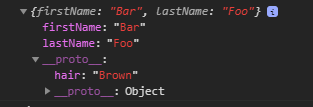Loops can behave differently when objects have chained prototype objects. Let's see the difference we get when we use the for-in loop on an object without a prototype, as opposed to an object with a prototype object.
Let's say you have an object:
const obj = { firstName: "Bar", lastName: "Foo" };
Once you use for in loop:
for (let property in obj) { console.log(property); // firstName, lastName n++; } console.log(n); // 2
We can add one prototype prop to the obj:
const protoObj = { hair: "Brown" }; Object.setPrototypeOf(obj, protoObj);


On the prototype chain we have 'hair' prop.
Now, if you use for in loop again:
for (let property in obj) { console.log(property); //firstName, lastName, hair n++; } console.log(n); // 3
Be to notice, 'hair' is on the prototype chain,is not on obj's own property, so if we want to fileter 'hair':
for (let property in obj) { if (obj.hasOwnProperty(property)) { console.log(property); // firstName, lastName n++; } } console.log(n); // 2